After the Florsheim Imperial Kenmoor, the most lamented made in USA shoe is the FootJoy Classics golf shoe. How do I know this? I took a poll. The sample size was small. One person actually. Me. But I do converse with people about shoes. Everyday. So, I have a good feel for what people are interested in. Shoe-wise. Not life-wise. No one asks me questions about solving their life problems. But I could be a life coach. “Hmm. That is a difficult situation. Have you considered buying a pair of shoes? I find that it helps. In troubled times. Which these are.” I wouldn’t be the worst life coach. Probably not the best. Somewhere in between.
This post covers some of my favorite FootJoy golf cleats as well as information on buying vintage FootJoy pairs. I have been wearing and collecting made in USA golf shoes for years. At one point I was planning on blogging about each pair. But I never found the time. Which is frustrating. And it’s frustrating to be frustrated with a writing hobby that I never started.
A Very Brief FootJoy History
FootJoy was originally founded in 1857 as the Burt and Packard Shoe Company in Brockton, Massachusetts. Later it changed its name to the Field and Flint Company. In 1957, another Brockton firm, Stone-Tarlow Co, purchased Field and Flint (I believe the “Tarlow” name is related to the Tarlows of Alden and Lloyd & Haig). In 1970, Field and Flint Company was renamed to Brockton Footwear Inc before officially adopted the FootJoy name in 1975. Since then there have been numerous owners of the company and is currently owned by the Acushnet Company. FootJoy continued to make shoes in Brockton until closing the plant in the depths of the Great Recession. Sadly, the plant closing ended the long history of shoemaking in Brockton.
FootJoy is obviously known for their golf shoes but originally made dress shoes. Sometime between 1910 and 1923, the company introduced golf shoe models. The shoes became very popular due their performance and quality as well as FootJoy’s superior marketing and customer service. By the 1950s, FootJoy boasted that the shoes were “worn by 9 of 10 home and touring pros”. While the golf share of FootJoy’s business was growing, in the 1960s roughly half their models were still “street” shoes. After the 1970 name change, the firm largely focused on golf.
What Makes Them Classics
The FootJoy “Classics” (a moniker adopted in the 1980s), were some of the best golf shoes you could buy outside of a bespoke pair. They were designed with a low, wide butyl leather sole that positioned your feet close to the ground which allowed for a firmly planted swing. With rubber soled shoes, there is more space between your feet and the turf. You sit a bit higher.
While most modern golf shoes typically only have one width (“medium”), FootJoy Classics came in ten widths and ranged from AAA to EEEE. Buyers also had a number of shoe lasts to pick from. This allowed a golfer to dial in their fit. And since the shoe was made almost entirely of high quality leather, the shoes molded to your feet making them very comfortable to wear over a long afternoon.
FootJoy was also innovative in their designs and patterns. They offered a wide range of styles and consistently updated their models with new leather combinations. You can see the variety of models in the 1970 FootJoy Catalog that I posted a couple years ago.
There were a few Classics model lines. All were introduced in the late 1980s or early 1990s. “Classics Lites” had a lightweight heel and sole. “Classics Dry” introduced a new specially tanned, lightweight “WaterLoc” leather outsole which gave the pair better water resistance. “Classics Dry Premiere” was the last model and was introduced in 1999. It used a combination WaterLoc and TPU (thermoplastic polyurethane) outsole.
Most pairs were made from high quality calfskin leathers but FootJoy also allowed for custom orders in exotic leathers such as lizard, alligator and ostrich. Custom pairs might take six months to make and were very pricey. One guy told me he paid $900 in 1979 for an alligator pair. FootJoy even had an option to have the custom pair made with hand welted construction.
The negatives on Classics were that they were expensive and somewhat heavy – around three pounds per pair. This limited their market. When production ended in 2009, sales had been declining for years and the shoes were a bit of an anachronism in that consumers had almost entirely moved away from welted, leather golf shoes to less expensive shoes made of synthetic materials. In the end, FootJoy simply didn’t sell enough pairs to keep the line going.
How to Find a Pair
Even though FootJoy no longer makes new Classics pairs, you can still buy them secondhand. New pairs typically range from $250 to $450 on Ebay. A lightly worn used pair will run between $75 and $125. New pairs priced under $200 will generally sell within a day. There is still a fair amount of supply but it takes patience to find a pair in a particular size and style. Sizes 9.5 to 12, medium to wide widths are the most sought after. One Ebay seller has a surprisingly large supply of Classics priced from $300 to $450.
To find a secondhand pair in lizard, alligator and ostrich is rare but of those skins, lizard is the most common. Lizard wears well but can tear if excessively dry. When listed, alligator pairs can sell on Ebay for $1000+. While alligator looks amazing, alligator is more delicate and unconditioned pairs can crack and flake. I have seen just one real (not embossed) Ostrich leather pair so don’t hold out any hope for finding a pair in your size. That ship has sailed. You missed the boat. [insert additional nautical idiom here].
Avoid the FootJoy “FJ’s” model. FJ’s pairs look like Classics but the upper leather is lower quality and they have a synthetic sole. Also avoid Classics where the model number starts with the number “9”. These are women’s shoes. The TPU portion of the Classics Dry Premiere outsole has not aged well and often cracks. Check the photos of the outsole closely before purchasing a pair.
If you need a Classics pair repaired or resoled, LaRossa Shoe Repair in Weymouth, MA specializes in FootJoy Repair. I haven’t personally used them but they have great reviews and the work they post on Instagram is excellent.
How to Date
Below are some tips for dating pairs
- Prior to 1968, FootJoy shoes had a four digit model number. They moved to a five digit code after that
- Field and Flint will be stamped on the soles of pre-1970 pairs
- The FootJoy logo changed in 1998, from “Foot-Joy” to “FootJoy” (sans hyphen)
- “Classics” started to be imprinted on the insoles in the 1980s
- Classics Dry and Lites were mostly made in the 1990s
- Classics Dry Premiere were made starting in 1999
- Pairs from the 1980s and on had a two digit date code on the inside of the shoes. The month is the first digit A=January, B=February, C=March and so on. The second digit is the year.

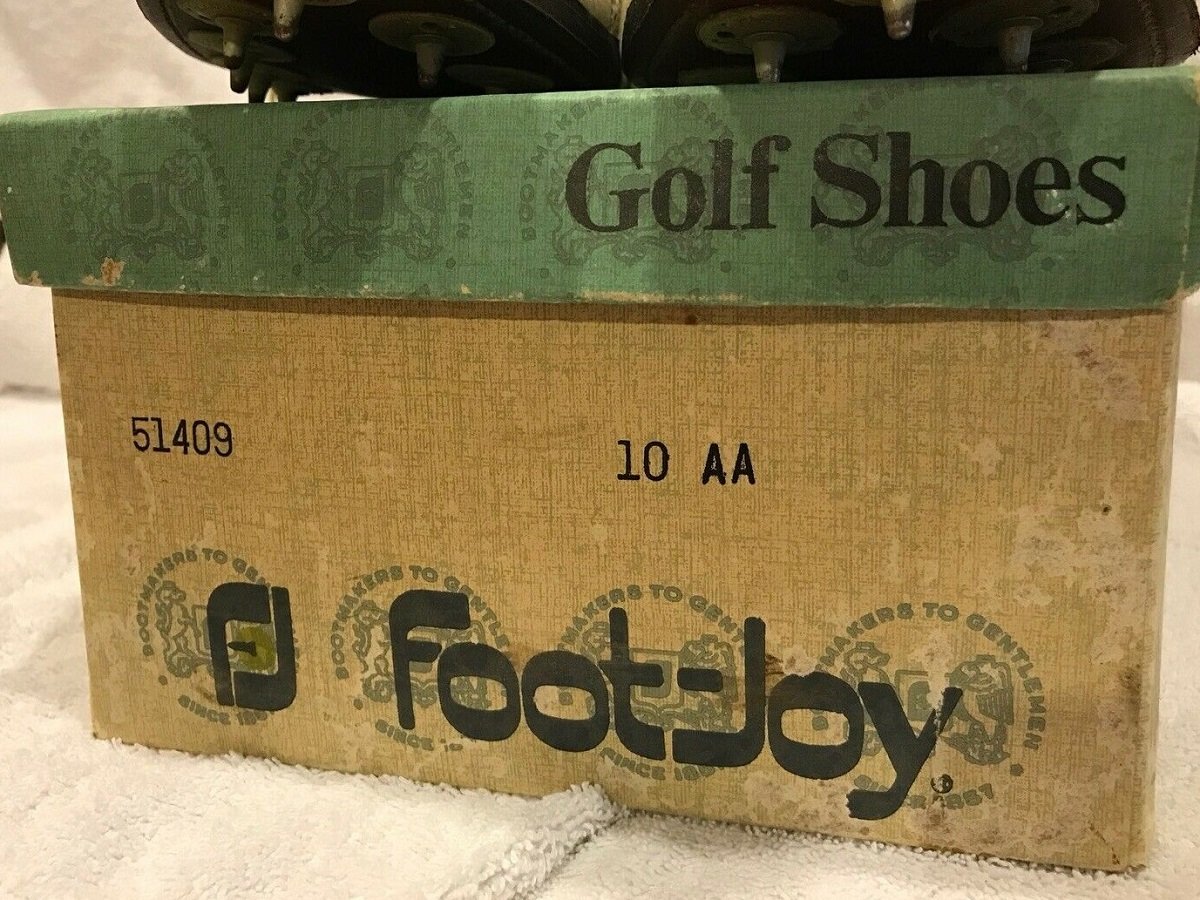

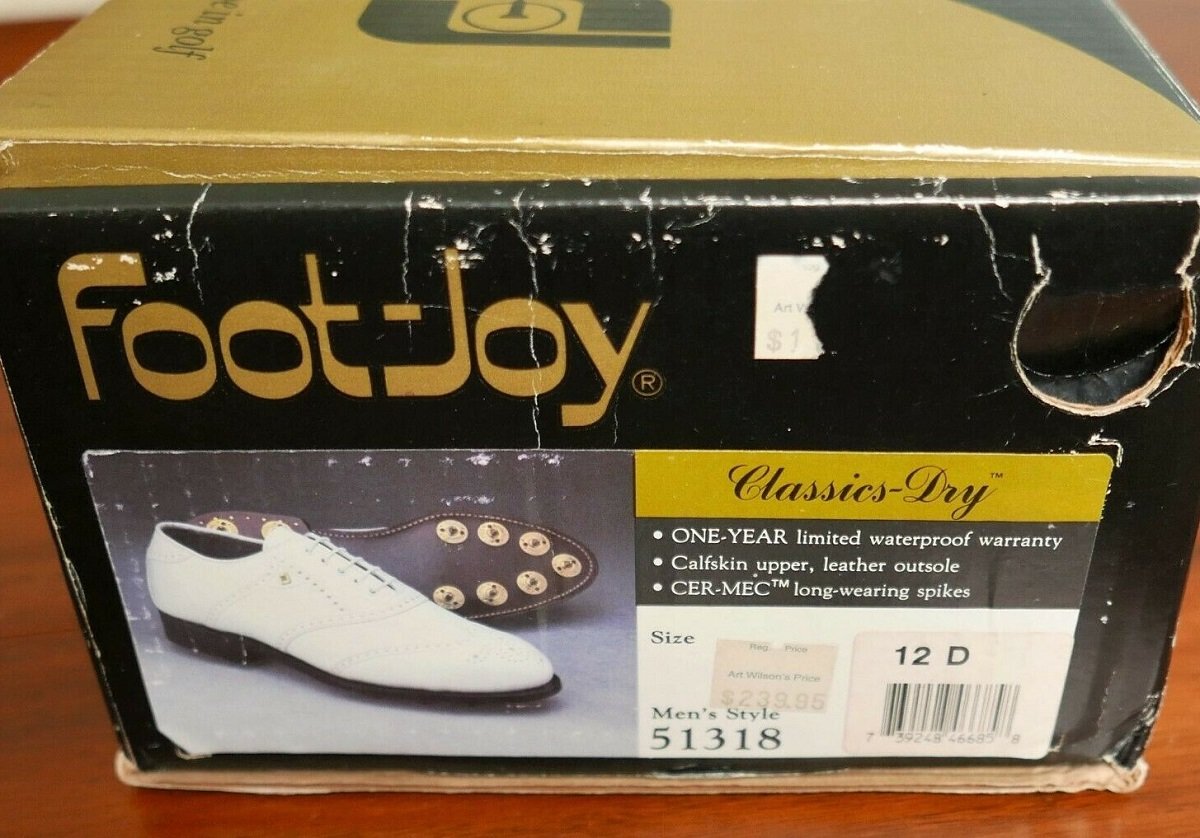

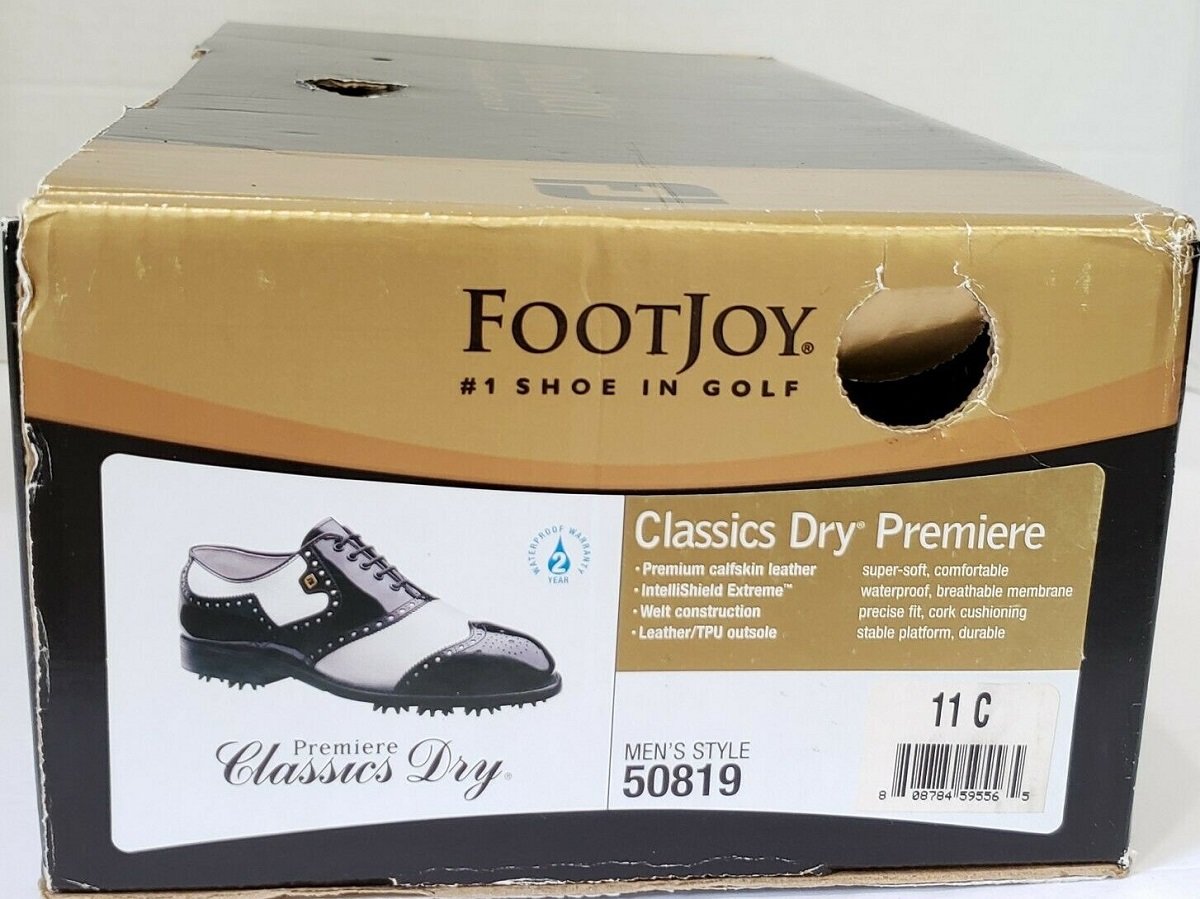
Some of FootJoy’s Best
Below are photos of some of my favorite pairs that I collected over the years. Recently I have been selling off much of the collection but have kept my favorite pairs. A shoe collection is fairly impractical. Golf shoes in particular. And especially golf shoes not in your size. As I remember Maslow’s hierarchy of needs, shoe collections are right above warm apple pie a la mode. Oh so tasty. I do have a couple Classics pairs I wear when golfing. I generally have the best shoes in my foursomes but unfortunately, my shoes are way better than my game.
FootJoy 56028 – U-Tip Blucher in Brown Tegu Lizard and Calfskin
This is my favorite pair and was made sometime in the 1970s. Just a great combination of leathers and color. The lizard skins are masterfully aligned to the shoe pattern.
FootJoy 56721 – U-Tip Blucher in Light Brown Tegu Lizard and Calfskin
Similar to the previous model but in light brown. Made in the late 1970s. The lizard skin kiltie (or shawl) is impressive.
FootJoy 51771 – Shield Tip Blucher in Green Patent Leather and Suede
I believe this pair was made in 1968 or 1969 on the Rex last. It has the 1960s FootJoy logo on the insole and “Field and Flint Co” imprinted on the outsole. A fun combination of leathers. Not a pair to pick for wet weather.
FootJoy 52233 – Bal Saddle Shield Tip in Black Patent Leather and Shrunken Calf
This pair was likely made in the late 1970s. It was a popular style and one that FootJoy kept in production until the end
FootJoy 70300 – Bal Saddle Brown Calfskin
This pair was made in the early 1970s on the Aintree last. I love the six exposed brass eyelets and the natural sole edging. The pair is heavy – almost two pounds per shoe.
FootJoy 5180 – Wing Tip Saddle in Black calfskin and Shrunken calf
The pair was made sometime in the 1960s. The quality of the pebble grain leather is much better than what you can buy today.
FootJoy 57380 – Bal Saddle Wing Tip in Purple Tegu Lizard
Made in 1992. Most lizard pair are either black or brown. This pair is purple. Purple! Maybe burgundy.
FootJoy 57331 – Bal Saddle Wing Tip in Green Tegu Lizard and Tan Calfskin
Made in 1995. Nice combo of lizard and calfskin. I have never seen an all green lizard skin pair but there is probably one out there.
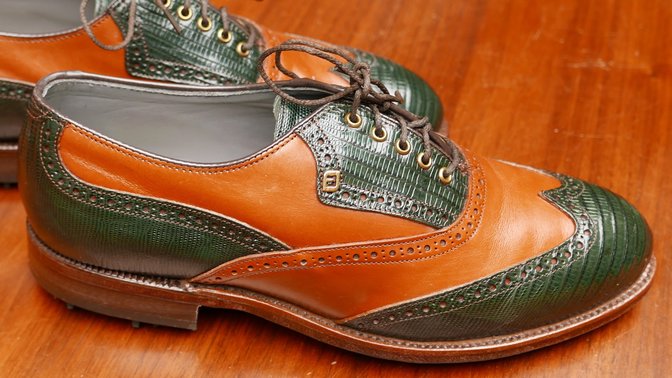
Final Thoughts
Hope you enjoyed the post. It took a while to gather the information. If you have any corrections or additions, leave a comment below.
See more FootJoy Classics pairs on my Watch List Search page.

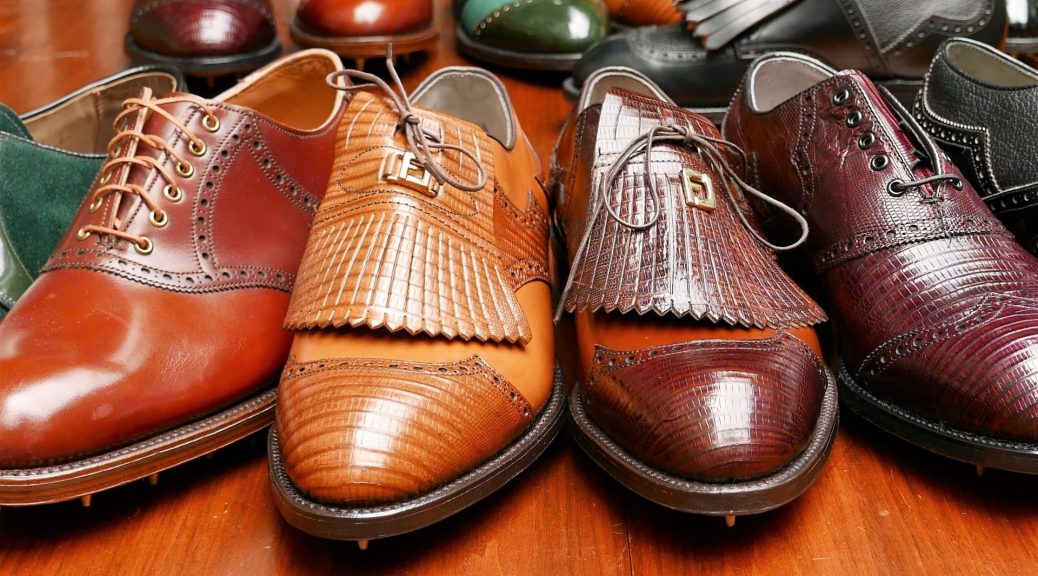
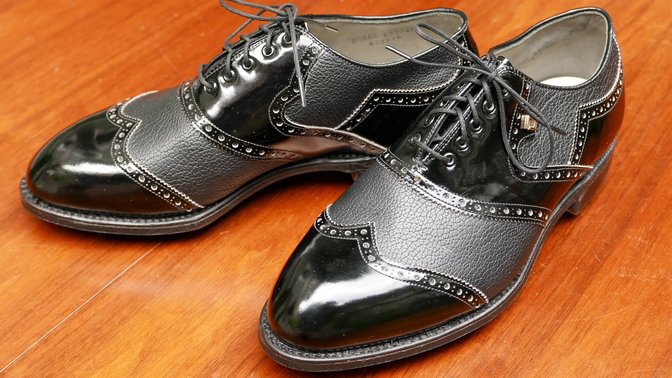


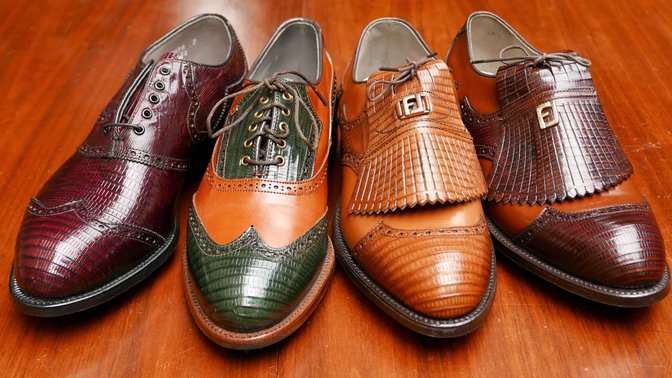
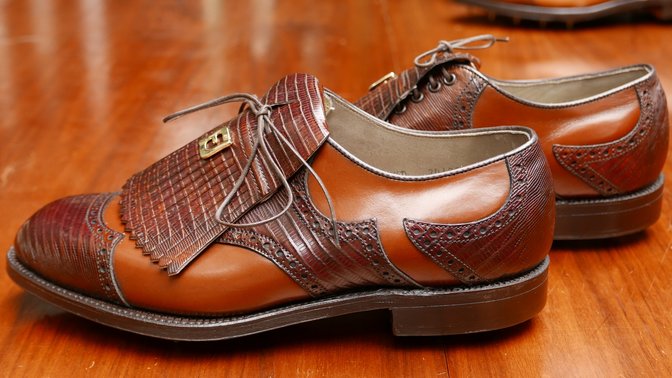
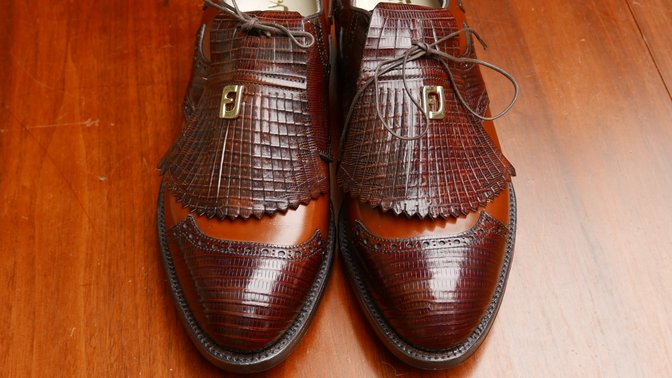


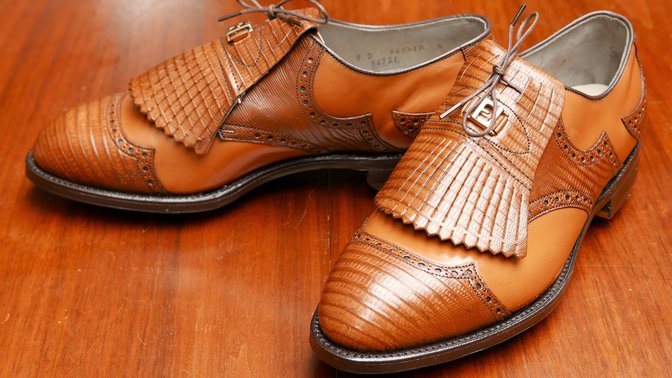


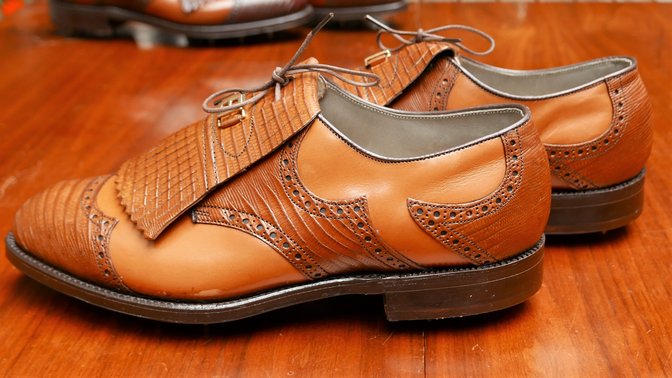
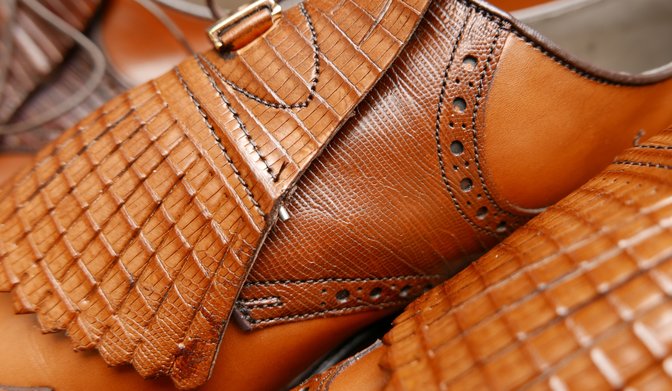
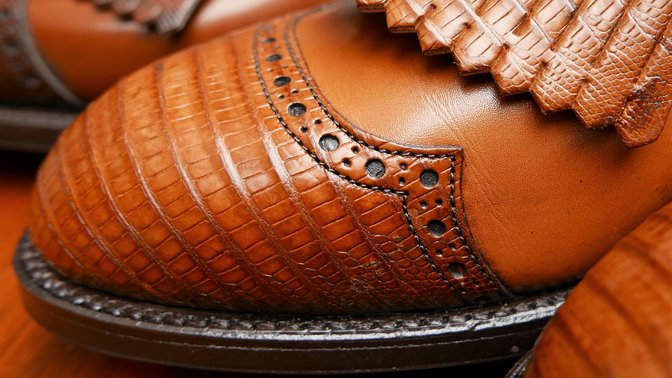


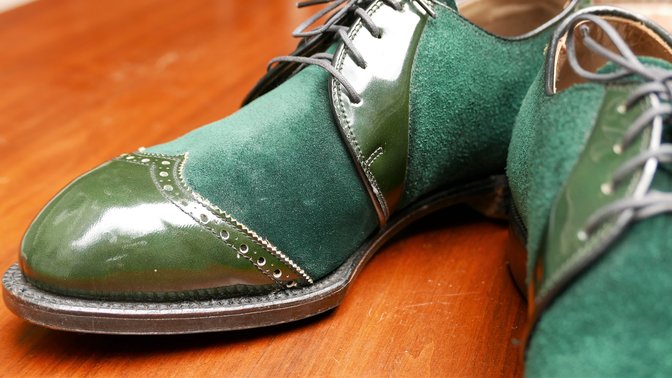



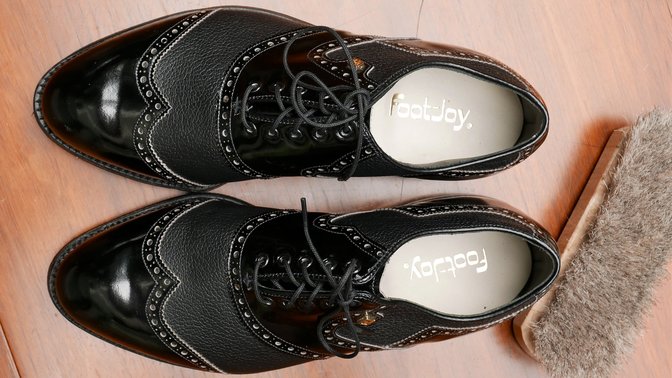
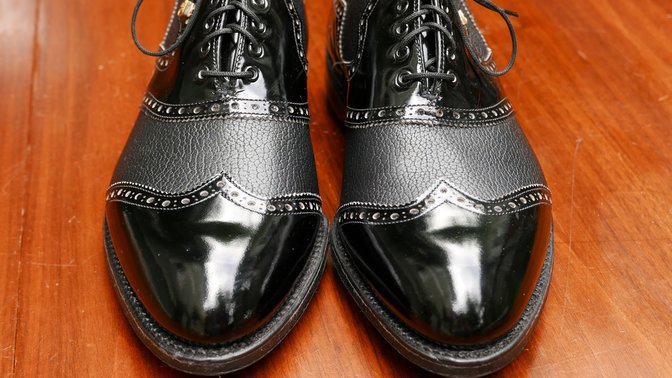

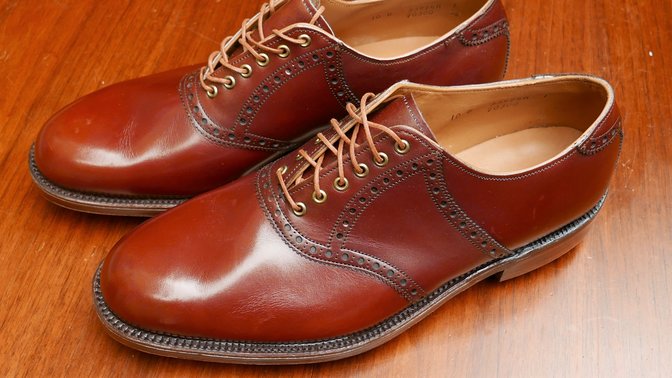
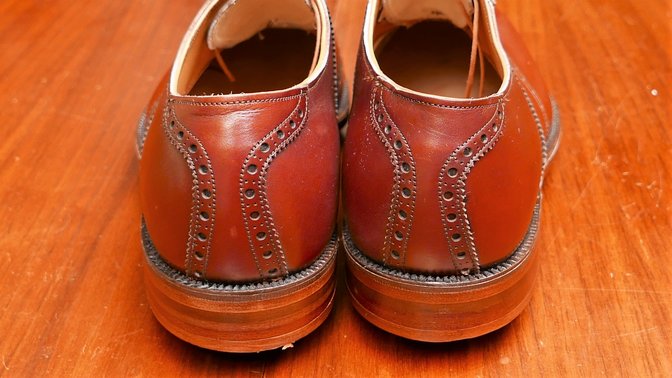



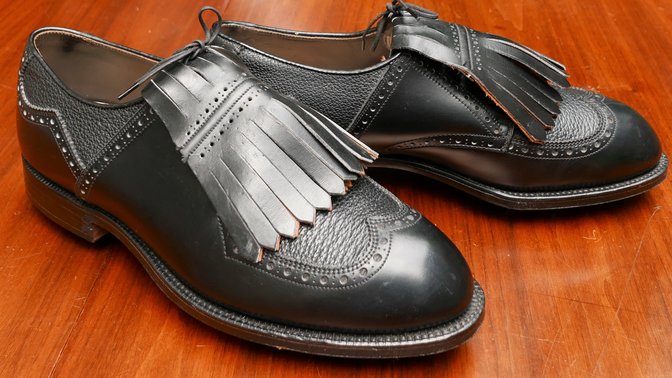
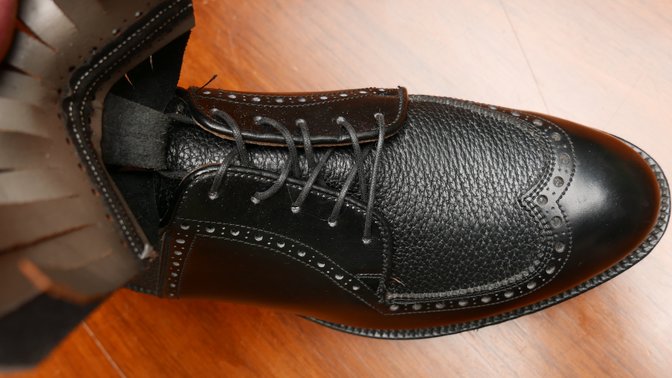
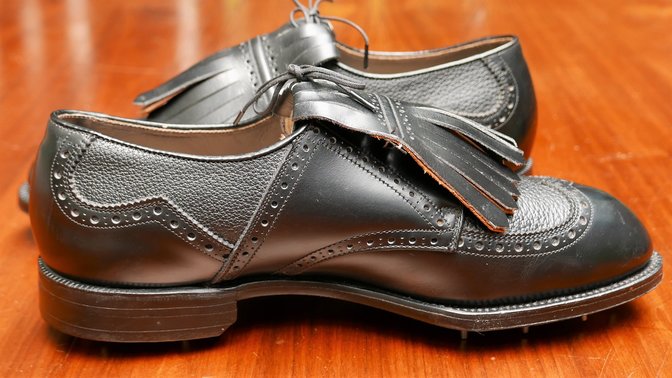
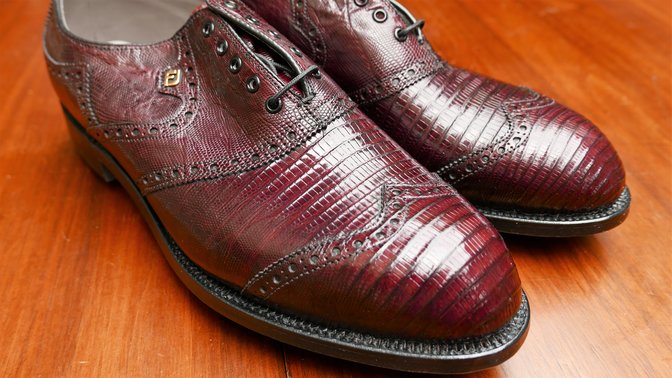
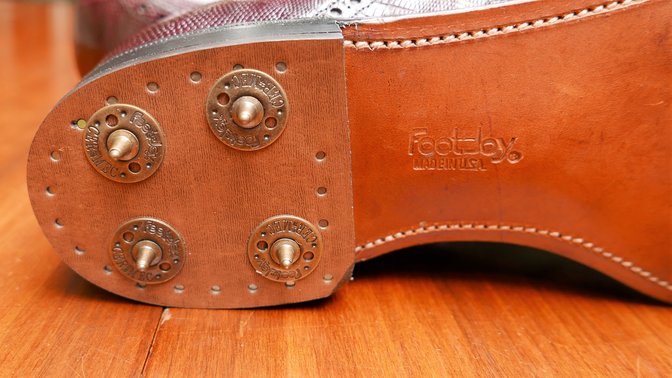


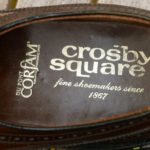
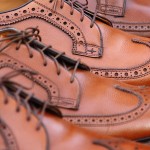

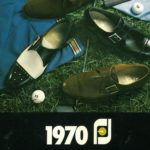
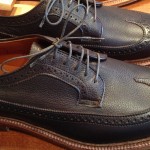
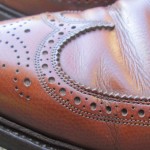
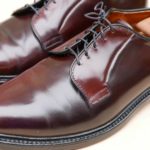
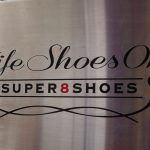
Cher David,
Votre blog est une somme d’informations incomparables et je pense pouvoir dire que tout le monde attend chaque nouvel article avec impatience.
Bien amicalement,
Patrick.
Thank you!
Fantastic! Those shoes are pieces of art. My favorite is the orange/pumpkin and green lizard skin. By the way, is the huge kilt functional in some way, or is it purely aesthetic?
Thanks. The kiltie is largely aesthetic but it does protect the laces. Its not a common feature on modern golf shoes.
Agree, what a gorgeous collection! I am shopping for golf shoes right now and, ugh.. no beautiful styling as on those to be found. And to answer your question, the kiltie could keep out the sand when playing from bunkers, I suppose. Or when someone else is, lol.
What amazing shoes! Beautiful. They’re almost enough to make me want to take up golf.
Thank you
Great article, David! If you can’t play worth a damn, at least you should look like you can. Some of these pairs are so old, I’m reminded of Judge Elihu Smails getting his ground on the buffer/sander by Porterhouse the locker room attendant!
https://www.youtube.com/watch?v=UQDMa55ZpKg
Thanks. That’s the greatest golf movie ever made. And the shoes are probably from that era
Golf shoes were always stylish.. I was on the golf team back in high School during the mid 80’s and our star player was not only a great player but he also wore the cool clothes as well.. He had a couple of pairs of golf shoes he would wear during the day.. He just removed the golf spikes and had a regular pair of shoes.. It was funny at the time but he always looked dapper.. Great memory.. Thanks for the informative article and nice photos..
Saw these on e-Bay this evening: https://www.ebay.com/itm/Footjoy-Vintage-Rare-ALL-Lizard-Classic-Golf-Shoes-11D/322904060452?hash=item4b2e94f224:g:NY0AAOSwDkVaGdaQ
David,
What a well done and informative article. I am the Ebay seller that you mention in your article. I’ve been collecting and dealing in Classics for many years, some of my collection I’ve had for decades. I’ve shipped Classics to over a dozen countries around the world and the U.S. and Canada. I was familiar with some of your tips on how to ‘date’ a pair of Classics, but not all of them…you certainly added some valuable information to my knowledge base. Thank you so much for the article, it was truly enjoyable….and you have some absolutely beautiful shoes.
Thank you. You have some great shoes as well. Thanks for keeping the community well stocked.
Gary,
You have undoubtedly the largest and most respectable collections offered on ebay. Please don’t block anyone who may share both you and David’s appreciation for these timeless Classics from potential purchases.
Rob
Gary – what’s your username on Ebay? I’d like to shop with you, however, the link in the article doesn’t direct us to you anymore.
Sadly Gary passed away a few years ago. He is missed.
David,
I see some Bostonian golf shoes that look identical to FJs. I think I read some where that they were made in the same factory or shared factory.
Do you know if Bostonian golf models are the same as FJs?
The Bostonian golf shoes have different construction than FootJoy pairs. So I don’t believe they were made by FootJoy.
Fantastic article..really enjoyed your collection..they truly are works of art.
I sourced several pairs of shoes after the closure and have 2 pairs left unopened. The beautiful black patent leather wingtips and a brown/metallic bronze wingtip. Just can’t bear to wear them….they are so ….Classic!!
Dear David,
Thank you so much for such a well documented article!
While I am not usually into golf shoes, these are splendid.
I personally have fallen in love with the Foot-Joy Classics tassel loafers whose rounded shape I find perfect.
However I noticed while searching that your rule about the hyphen seems contradictory on this pair : https://www.ebay.com/itm/254476396934
No hyphen but still Classics with C2 (Marche 82?).
Would love your opinion on this.
Cheers
I think that pair was made in 2002
Hi David,
Thank you for the informative article. I was cleaning out my garage and found a brand new pair of Footjoy Classics Lites model 52050, black leather still in the box, in the Footjoy plastic bags and with the original purchase receipt. Made C9 (March 1989) and I purchased them in October 1989. Don’t know why I never wore them. My Dad bought me my first pair of Footjoys when I began playing golf in 1963 – they made kids sizes as well.
how’d I do on my ebay score? https://www.ebay.com/itm/254456659113
I have a black pair that I have’nt worn for years and would like to date them. The details are:
67302R
Size 12E/11EU
Lo Style
They are fairly heavy but still in excellent shape. I am thinking of selling them and have no idea of their value.
I would be grateful for any information.
Further to my post above, I omitted the number 56964N (after Lo Style). Frank
Its tough to say how much they will sell for but if they are in great shape, then likely somewhere between $100 and $150
Thanks David.
By way of alternative, I’ve been in touch with La Rossa in the USA (recommended by FootJoy) about having them re-furbished, however it is expensive taking the shipping costs both ways into account – total about $350. They think the shoes are well worth doing since they are in ‘as new’ condition apart from the soles. There are ‘new’ classics for sale on eBay for around $ 350 – $400, so it begs the question. Interesting thought! It doesn’t seem that anyone in UK/Europe does refurbishing.
If the shoes fit well, the upper is in good condition and you will wear them regularly, then it is worth having them restored for that price. Otherwise it is not. La Rossa does excellent work.
Many thanks for your advice David.
Frank
Indeed David, spot on. I just received my first refurb from LaRossa and I’m very impressed with the craftsmanship. New leather soles, heals, spikes, cork layers, and interior linings for about $250 including shipping in the U.S. I’m not aware of any other cobbler that has the experience with Classics that LaRossa has. I’ll be sending them another pair this Fall.
Any idea how much the 56721’s go for. Brand new and never used still in the box.
Today? Likely somewhere between $500 and $1500 but I haven’t seen another new pair in years so that is a guesstimate.
Do you know where the best place to sell them is?
Ebay has the most vintage golf shoes for sale
What about 57513 new in box?
Probably $200 to $400
I got an offer for $550
Great. Did you sell it on ebay?
Hi David!
What a wonderful article. Would you have any interest in selling the lizard wingtip by chance?
Thank you,
John
I am not selling them right now but you can always send me an offer. My email is on the contact page.
Great article, many thanks.
Look here for some fantastic rare Footjoys,
Might need deep pockets however!
https://classicshoesformen.com/?swoof=1&pa_maker=footjoy
Nice article. Great info and thanks for sharing. I’m a golf nut, player and collector of classic equipment (~600 clubs) and classic shoes. I’ve been selling various FootJoy classics on ebay for 5 years or so. I typically sell 150-200 pairs annually. I have about 50 in my personal rotation, and about another 150 pairs I need to post for sale. If folks are interested let me know!
Thanks. Post the link to your ebay store so people can find your shoes.
I’m taking a break on eBay at the moment to focus on me as it was consuming a lot of time. I never had an official store there. Just a golfer and FootJoy classic nut who was collecting and selling. My username on eBay is mcnash416. If anyone is interested in FootJoy classics or icons just hit me up at golfunderpar18@yahoo.ca and provide your size and location. Cheers all!
Michael N, I’d love to know what you’ve got in a 9E / 9EE!
Email me directly and let me know where u are located and the size. I can share photos and info via email. Golfunderpar18@yahoo.ca.
Email me per my post and I can advise. Confirm the sizes and location. I have mostly sizes between 8-10 and about 150 pairs in my inventory. Want to sell what I have and not planning to replenish my collection. Golfunderpar18@yahoo.ca.
The old black patent leathers were my all-time favorite shoes. Had a pair at end of high school into college and absolutely loved them and wore them all the time. Greatest looking Foot Joy shoe IMO. You just looked like a player when those were on. Great memories.
Your article on Classics was great. I have about 12 pairs of Classics in several styles. When I started taking golf seriously in the mid to late 60s I couldn’t afford Footjoys. I always wanted a pair. In high school I got a pair of cool Ben Hogans, that I loved, but It wasn’t until I was in college in the mid 70s that I got my first pair of Footjoy Classics. Now I can afford them, but they no longer make them. So I hunt for them on eBay and I have been very lucky to have scored some great shoes. I am looking at a pair of my shoes right now that I get a lot of comments on: 13D 48730A 10 / Style 56549 (no date code). Bal Saddle Wing Tip in a beautiful Light Tan Calfskin. Questions: Does the style number include the color & type of leather/skin? Is there a reference list of colors, types of leather/skin with code numbers? Why no date code? Foot-joy is hyphenated. People ask me what color the shoes are and I say tan. It seems like the colors should have a name like Whiskey or? Did Footjoy name colors? Thanks, Bob
Hey Bob – I don’t have any information on that model. I looked in a couple of my old catalogs and didn’t see the pair. Based on your description the pair sounds like it was made in the 1970s. During that period, the shoes had no date code. They might have been called tan or just brown. The model number doesn’t appear to be a code that would indicate the style, leather and color. That’s all I got.
David, how does the sizing for foot joy golf shoes compare to dress shoes (Florsheim, Nettleton, etc)? I assume it’s the same, but curious before looking. Thanks!
FootJoy used a number of different lasts so the fit probably depends a lot on that. The Rex last was more narrow than the Aintree last. I would size up with the Rex. The more modern Classics were on the Laser last which seemed true to size.
David,
I had seen you have some Footjoy Green Suede 51771. I have a pair and am curious what you think they are worth.
Thanks.
If they are new, probably $200 to $350. If they are used, $75 to $125. Narrow sizes don’t sell well.
Hello! My significant other has quite a few (as in 20+ pairs) of these golf shoes. He inherited from his grandfather and he thinks a couple were from his great grandfather. I’ve been looking around and I’m having a tough time trying to figure out how to differentiate them. You’re article was an interesting read and I learned some. However I still don’t know what I have here exactly. Is there a website you might know if where I am able to type the digits in and it would be able to give me a little something more? Feel free to contact me at ader.brittni07@gmail.com
Have 13 pairs my significant other inherited from his grandfather. Very good condition still a little aging but that’s what makes them even better. Anyone know a good site to gain more info or help on how to identify each pair?
I think, that you are mistaken. I suggest it to discuss. Write to me in PM.
I am unsure how to send you my contact info privately.
Brittni.lefevere07@gmail.com email me
I suggest you to come on a site on which there is a lot of information on this question.
Great information in your article. I believe I have come across a rare pair of FJs. There appears to be only a 4 digit code and based on info here that would be pre 1968. They are brown lizard skin brogue Derbys. Resoled for sure but in great shape. Any idea what they might be worth?
Probably not much if they have been resoled. Most people are looking for new or lightly worn pairs.
I actually don’t think they have been after doing more research. They look just like the lizard skin 57380 that you have posted but plain toe and not wingtip. The model number is 7205 single line of print.
Hi everyone, I recently started a Facebook group called “Footjoy Classics Enthusiasts,” if anyone would like to join.
Hi, I would like to join the Footjoy Classics Enthusiasts Facebook Page. Thank you!
Sandy Wilder
Hi Sandy, Please visit https://www.facebook.com/groups/1151895156201024/ and join us. Let me know if you have any issues.
Jacj
Do you have any example photos of the FJ Line? I’m not seeing many results online. Are these the rubber sole, spikeless model?
I don’t have any FJ photos but you can usually find some on eBay. The outsoles typically are not leather but do have spikes.
Is there anything you can do, other than visually inspecting for cracks, to identify “bad” TPU on the Dry models? Can you condition the TPU or treat it somehow to make it more robust?
And is the TPU prone to dry-rot? I’ve bought older Footjoys before that looked great, but the sole essentially disintegrated on first wear.
I am not aware of any treatments for TPU. I don’t believe you can fix cracked TPU. You can get it replaced but there aren’t many cobblers who will do that. I have given up buying older TPU models because it cracks so often.